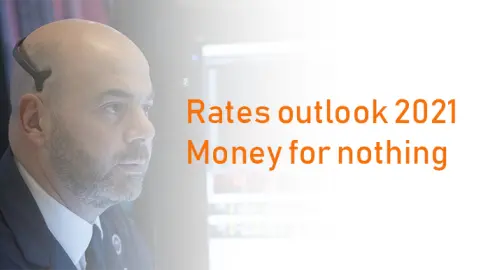Rates 2021: No need to worry, yet
The US deficit is eye-watering. And it needs to be financed. Such are the sizes involved that it is not difficult to see how this could be a problem. That said, for as long as there is offsetting demand it does not need to be a determining factor the bond market. So far, and through 2021, we see demand for bonds holding up. But this issue will not go away
The US deficit shoots to the skies, and now must be financed
As Covid-19 struck and the economy came to a government-induced shudder, the cost of covering that hole began to explode. As a consequence, the build of the US fiscal deficit in 2020 has been nothing short of astonishing. From April to October 2020, the US ran a deficit of $2.7trn. That compares with a deficit of about $0.4trn over the same period of 2019, an eye-boggling excess of $2.3trn. That excess alone amounts to about 11% of the size of the US economy. In total over the Covid-struck twelve months spanning from April 2020, the deficit is likely to be at a running rate of close to 20% of GDP.
US deficit rocketed higher to finance stimulus, and the pain continues

Deficits need to be financed. The first port of call was the bills market. Very quickly, bills issuance began to fill the required funding needs, and indeed the Treasury added to that by building a cash balance to around $1.5trn. And the cash balance remains at about that level, partly in anticipation of immediate requirements but also as a new stimulus package has been expected. The fact that this has not come to fruition (yet) has taken some pressure off. It has also meant a halving of targetted bond issuance in the next number of months.
However, the deficit financing pressure remains. First, as some of the bills' issuance will be slowly rolled out the curve into more longer-dated issuance. And second, as there will likely be a stimulus package coming, with at least a $1trn handle on it.
Time to get worried about the deficit? Yes, but no need to panic just yet
Supply can be a swing factor if there is inadequate demand. So far, demand has been impressive. Flows into government bonds remain robust, and the expectation ahead is for this to remain the case. Money market funds however have seen fewer inflows, and in fact, prime funds have seen outflows as a theme. The market capitalisation of commercial paper has also been falling. There is still decent demand for government bills, but it is not a route that should be aggressively tapped on through 2021. Rather the onus will be on supply and demand in longer tenors.
Provided the average coupon print is below the nominal GDP growth rate debt dynamics can be contained
Then there is the question of debt dynamics, and whether we should be concerned about that from a US perspective. Generally speaking, provided the average coupon print is below the nominal GDP growth rate, debt dynamics can be contained. This can be complicated by the size of the primary positive and the debt/GDP ratio itself, but these are not key determining factors for the US. And the other big issue is the Federal Reserve. For as long as the Fed is there buying paper and willing to buy more, there is little to fear on the weight of debt front. Overall flows into Treasuries remain a supportive factor.
Flows into core government bonds have remained impressive despite the low (but rising) yields

That is not to suggest there are no risks here. There are. But we see this as a bigger worry for further along 2021 and into 2022. The roll-over of debt will be an ongoing factor to take into consideration then, and especially if it coincides with some build of inflation (most likely from the service side of the economy). For now though, we think supply will be met by demand.
And by the way, the Federal Reserve has played a good game, and is still in the game
On top of the support from the Treasury, a whole litany of exceptional help has been provided by the Federal Reserve in an effort to protect both the financial system and the economy. These have been successful. The exceptionally low level of 3mth Libor is one measure of this. The other is the only moderate discount on the EUR leg of a cross-currency swap versus USD. Typically, or at least in prior crises, a significant build in a USD premium would build as players scrambled for USD, manifesting in a large EUR discount.
The actions of the Federal Reserve have helped to prevent this, and have helped ease any perception of liquidity constraints into the turn of the year. It looks at this stage that the Federal Reserve will not need to beef up support for money markets, credit markets, commercial paper markets or USD lines. But the Fed will keep policy easy and keep that QE programme humming through 2021.
This publication has been prepared by ING solely for information purposes irrespective of a particular user's means, financial situation or investment objectives. The information does not constitute investment recommendation, and nor is it investment, legal or tax advice or an offer or solicitation to purchase or sell any financial instrument. Read more
Download
Download article
19 November 2020
Rates Outlook 2021: Money for nothing This bundle contains 12 Articles